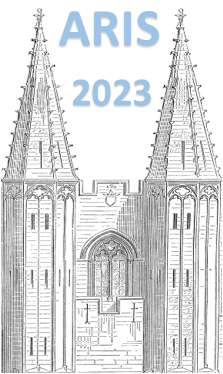Aaron Chester
(Facility for Rare Isotope Beams, Michigan State University, East Lansing, Michigan 48824, USA)
Adam Hartley
(Facility for Rare Isotope Beams, Michigan State University, East Lansing, Michigan 48824, USA)
Alexander Volya
(Department of Physics, Florida State University, Tallahassee, Florida 32306, USA)
Amelia Doetsch
(Facility for Rare Isotope Beams, Michigan State University, East Lansing, Michigan 48824, USA)
Andrea Richard
(National Superconducting Cyclotron Laboratory, Michigan State University, East Lansing, Michigan 48824, USA)
Augusto Macchiavelli
(Physics Division, Oak Ridge National Laboratory, Oak Ridge, Tennessee 37831, USA)
Axel Frotscher
(Nuclear Science Division, Lawrence Berkeley National Laboratory, Berkeley, CA 94720, USA)
Benjamin Crider
(Department of Physics and Astronomy, Mississippi State University, Mississippi State, Mississippi 39762, USA)
Brenden Longfellow
(National Superconducting Cyclotron Laboratory, Michigan State University, East Lansing, Michigan 48824, USA)
Carlotta Porzio
(Università Degli Studi di Milano/TRIUMF)
Christopher Campbell
(Nuclear Science Division, Lawrence Berkeley National Laboratory, Berkeley, CA 94720, USA)
Christopher Morse
(Brookhaven National Laboratory, Upton, New York 11973, USA)
Christopher Prokop
(Los Alamos National Laboratory, Los Alamos, New Mexico 87545, USA)
Dariusz Seweryniak
(Argonne National Laboratory, Argonne, Illinois 60439, USA)
Eleanor Ronning
(Facility for Rare Isotope Beams, Michigan State University, East Lansing, Michigan 48824, USA)
Elizabeth Rubino
(Facility for Rare Isotope Beams, Michigan State University, East Lansing, Michigan 48824, USA)
Filip Kondev
(Argonne National Laboratory, Argonne, Illinois 60439, USA)
Heather Crawford
(Nuclear Science Division, Lawrence Berkeley National Laboratory, Berkeley, CA 94720, USA)
Ian Connor Cox
(Department of Physics and Astronomy, University of Tennessee, Knoxville, Tennessee 37966, USA)
J. A. Winger
(Department of Physics and Astronomy, Mississippi State University, Mississippi State, Mississippi 39762, USA)
James Allmond
(Physics Division, Oak Ridge National Laboratory, Oak Ridge, Tennessee 37831, USA)
Jason Harke
(Lawrence Livermore National Laboratory, Livermore, California 94550, USA)
Kay Kolos
(Lawrence Livermore National Laboratory, Livermore, California 94550, USA)
Kevin Siegl
(Department of Physics and Astronomy, University of Tennessee, Knoxville, Tennessee 37966, USA)
Krzysztof Rykaczewski
(Physics Division, Oak Ridge National Laboratory, Oak Ridge, Tennessee 37831, USA)
Maninder Singh
(Department of Physics and Astronomy, University of Tennessee, Knoxville, Tennessee 37966, USA)
Mejdi Mogannam
(Facility for Rare Isotope Beams, Michigan State University, East Lansing, Michigan 48824, USA)
Michael Carpenter
(Argonne National Laboratory, Argonne, Illinois 60439, USA)
Miguel Madurga
(Department of Physics and Astronomy, University of Tennessee, Knoxville, Tennessee 37966, USA)
Noritaka Kitamura
(Department of Physics and Astronomy, University of Tennessee, Knoxville, Tennessee 37966, USA)
Paul Fallon
(Nuclear Science Division, Lawrence Berkeley National Laboratory, Berkeley, CA 94720, USA)
Rahul Jain
(Facility for Rare Isotope Beams, Michigan State University, East Lansing, Michigan 48824, USA)
Robert Grzywacz
(Department of Physics and Astronomy, University of Tennessee, Knoxville, Tennessee 37966, USA)
Robert Janssens
(Department of Physics and Astronomy, University of North Carolina at Chapel Hill, Chapel Hill, North Carolina 27599, USA)
Ruchi Mahajan
(Facility for Rare Isotope Beams, Michigan State University, East Lansing, Michigan 48824, USA)
Ryan Tang
(Department of Physics, Florida State University, Tallahassee, Florida 32306, USA)
Samuel Tabor
(Department of Physics, Florida State University, Tallahassee, Florida 32306, USA)
Sapan Luitel
(Department of Physics and Astronomy, Mississippi State University, Mississippi State, MS 39762, USA})
Sean Liddick
(acility for Rare Isotope Beams, Michigan State University, East Lansing, Michigan 48824, USA. Department of Chemistry, Michigan State University, East Lansing, Michigan 48824, USA)
Shree Neupane
(Department of Physics and Astronomy, University of Tennessee, Knoxville, Tennessee 37996, USA)
Soumik Bhattacharya
(Department of Physics, Florida State University, Tallahassee, Florida 32306, USA)
Tawfik Gaballah
(Department of Physics and Astronomy, Mississippi State University, Mississippi State, Mississippi 39762, USA)
Tim Gray
(Physics Division, Oak Ridge National Laboratory, Oak Ridge, Tennessee 37831, USA)
Timilehin Ogunbeku
(Facility for Rare Isotope Beams, Michigan State University, East Lansing, Michigan 48824, USA)
Toby King
(Physics Division, Oak Ridge National Laboratory, Oak Ridge, Tennessee 37831, USA)
Tyler Wheeler
(Facility for Rare Isotope Beams, Michigan State University, East Lansing, Michigan 48824, USA)
Vandana Tripathi
(Department of Physics, Florida State University, Tallahassee, Florida 32306, USA)
Wei-Jia Ong
(Lawrence Livermore National Laboratory, Livermore, California 94550, USA)
Zhengyu Xu
(Department of Physics and Astronomy, University of Tennessee, Knoxville, Tennessee 37966, USA)

